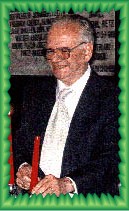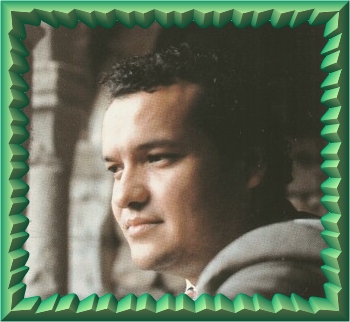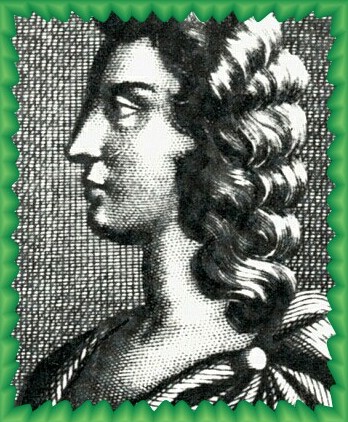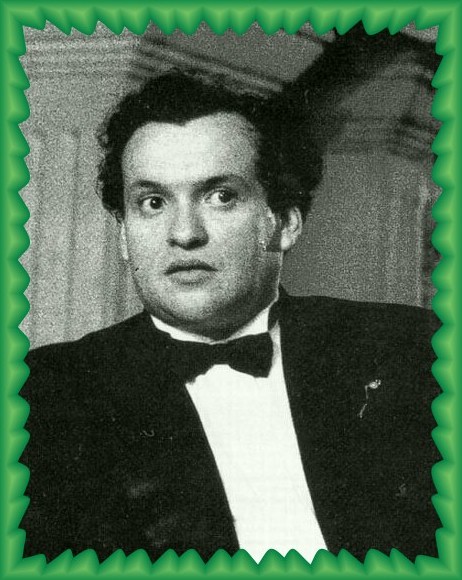

Forewords
There are probably not so many who have heard about Paolo Abel do Nascimento. He participated once in a "background" role as a castrato in "Dangerous Liaisons" for a few minutes and made two commercial recordings, before he suddenly died of an AIDS related illness at a young age. And yet, he is still considered to be of the outmost importancy in the modern history of male sopranists. Reffered by many to as a natural castrato, this mysterious singer had always fascinated, and continue to fascinate many of his listeners. His voice is like "no other", his manner of singing is often comic, exploding, but non the less charming and touching.
At first it may appear for some that his technique is weard, but after a better listen, it reveals an enourmous talent of dedication and artistry. In many ways, Nasimento was a true master of his style. It was his very own, unique way to sing - it was the way he chose to bring the message of the song on to his audience, loaded up with a touch of personal dedication and feelings. Otherwise, here he is, Paolo Abel do Nascimento, whoes background is enshrined in mystery, but whoes voice and talents speak for themselves.
The Biogarphy
Paolo Abel do Nascimento was born in 1957, in at that time a small town of Fortaleza, in the northen Brazil. His family was one among thousands other poor families with many children to feed and take care of. However, his family must have been unusually large, giving the fact that he was the 15th (!) child. Obviously, growing up in such a huge and poor family wasn`t easy at all. Still, Nascimento was the only child in his family who had a great passion for singing, and he followed in the steps of his grandmother, who was singing in the churches.

From the early childhood his musical talents became obvious to everyone. As a yong boy, he dreamed of becoming a professional singer. He was noticed as outstanding allready in the school, and despite the limited means of his parents, he was allowed to enter the University of Sao Paulo. There, he studied more music theory, including composition and orchestral conducting. At the university he met a French musicologist and conductor Roger Cotte, who was greatly satisfied with the young singers attractive voice and talents. However, he got himself a bit of a surprise when he noticed that Nascimento passed 20 and still had his infantile, high-pitched voice, pretty well intact. At first it was thought he had a delayed puberty, but as the time went on, "nothing" happened.

During a thorough medical examination, the conclusion was therefore clear: Nascimento had a certain endocrinological condition wich prevented his voice from breaking, as well as some other secondary sexual characteristica to appear, including facial hair growth etc. In other words, Nascimento was what we call today an endocrinological castrato. Realising the potentiality of such a case, Cotte created a quarted with 3 tenors and one soprano part wich was song by Nascimento.
This condition turned out to be extremely beneficial, as Nascimento`s unique and captivating alto voice attracted the sponsors, who were willing to provide whatever is neccesary in order to give Nascimento an exceptional opportunity to get a better and more sophisticated musical education in Europe. As a result, he left his native Brazil in the late 1970`s and went on to Italy. It was there particulary that Nascimento finally completed his vocal technique in the true Baroque style, and gave his first debut on the Belgian radio in 1981.
In the following years he performed occasionally on the stage and in private concerts in Germany, Austira, Belgium, France, Italy and on one occasion in the USA. By that time Nascimento had developed an obvious Baroque repertoire, and most of the music he performed were therefore from that period. This included such operas as "Xerxes" and "Tamerlano". Though Nascimento was mostly active in France, where he had his appartment in Paris, one of his most succesfull and famous performances were in Austria and Italy. He was particulary noticed for his performances in Venice, under the city carnival of 1990. Otherwise he became a great attraction for the tourists to Ajaccio, Corsica, where he sang in the imperial chapel, and everyone thought at first it was a child singing with a beautiful voice, but when they looked up, they saw him, an adult with the voice of a child.. The amusement of the tourists and other visitors were great, and the Belgian newspaper, "L'Evenement du Jeudi", wrote later afterwards that he "was the only vocal case in the world. He is perhaps the only natural castrato singer of our days ".
Apart from that, as mentioned above, Nascimento settled in France and spent most of his musical activities there. He appeared together with the singers François Miterrand, Jesse Norman and Jack Lang, in Lyon and Paris. Naturally, due to his growing popularity he decieded to start making recordings. His first commercial recordings took place in Aveyron, France, during the fall of 1986. Here he recorded 6 Sonates/Cantates by Domenico and Alessandro Scarlatti. The recording was later issued, through a contract, under the French label "Lyrinx" (LYRCD-62).

Then, 2 years later, he was offered a role as a castrato in the movie "Dangerous Liaisons". The role lasted for 2,5 minutes only, and it was thought to be so unsignificant that his name didn`t even appear on the main cast list. However, it was the one and only video performance of Nascimento. And it`s really amazing to see and hear him perform one of the most celebrated Baroque Arias, namely "Ombra mai fu" from Handels "Serse".

The Aria was written originally for a soprano castrato, and was first performed by the famous Caffarelli in 1738. Obviously, it wasn`t without a reason that Nascimento was chosen for this role. Since he already was an end. castrato, he was pretty close both physically and vocally to these legendary singers, who flourished especially during the period this movie was about. In fact, he was carefully chosen out of some 150 other candidates! All in all, I think he did a great performance here, and both the costumes, scene and singing style was especially adapted to the Baroque fashion.

The last recordings took place in December 1990 in Lyon, France, and lasted for two days only. This time Nascimento attempted a completely different repertoire - his native Brazilian folksongs. These songs is said to have a special and nostalgic influence on him, since they were "the songs of his childhood". However, it seems that at the time of his last recordings Nascimento was already severly affected by progressive HIV, and by the spring of 1992, he was compelled to cancel all of his scheduled performances, including an important concert in favor of the poor children of the Brazilian slumquarters at Ayrton Senna, in London. Eventually, he died on May 8, same year, to the great surprise and lamentation of the disheartened relatives and friends.
The probably most extraordinary voice since the times of Moreschi was now no more, but unlike Moreschi, it was enshrined for centuries to come on discs recorded with a modern technology, thus preserving his voice noise-free and clear. Naturally, one would ask how far a singer (and actor!) of his calibre would reach if it wasn`t for this highly dramatic and sudden end of his career. Most certainly is it, however, that we would have a great deal of interesting recordings, and possibly even movies (!), influenced and inspired by Paolo Abel do Nascimento, seen upon as a naturally gifted countertenor by some, while as a modern castrato by others - one can but only guess, how high his fame would be today, have he been alive.
Afterwords
Much has been said about the supposed "extraordinarity" of this singer, as his unique and natural high-pitched voice and his somewhat effeminate appearance gave a basis for various speculations, and the rumors were many - some even has it that he was a "secret" castrato, a reemergence of a breed known as "castrati" back in the Baroque. The fact that his family bitterly resisted an attempt to make an autopsy after his death, could add to that speculation, but than again, their reasons might have been based on religious believes, ruther than anything else. Although it could be possible, it looks much more reasonable that the condition behind his "castrato-like" voice and appearance was on a solely endocrinological level - inherited at birth, he was a rare case of what we today call an endocrinological castrato.

Many have therefore asked such questions as "How much can his voice give us an idea of the real castrato voice?". Indeed, it is not easy to answer this question - there is no recordings available of a single Baroque castrato! The one that actually recorded, Alessandro Moreschi, was well past this time, and his style, not to mention his repertoire, was totally different from that used in the times of Baroque. And than again, it is almost the same as to ask who posess a typical male or female voice - the individual variations between the singers and their voices in general is so profund that it is difficult to draw any certain conclusions from Moreschi recordings alone. However, the voice is a voice, and the only thing we can do now, is to compare Nascimento`s voice to Moreschi`s.
This is the only way we can attempt to answer this question, though perhaps, only partly. We know that Moreschi was a castrato, and by comparing these two voices, we may come further than any other speculations based on contemporary accounts describing singing of famous castrati. So, how does Nascimento compare to Moreschi? The first that comes in mind is that Moreschi sounds somewhat more powerful and voluminous in comparison - his voice is more "full", while Nascimento`s is "dry".
With other words, regardless how powerfull Nascimento may sound in comparison to other sopranists, Moreschi sounds even more powerful, and Moreschi`s voice is more rich, less stressed in the high notes, and doesn`t have that feeling of forcing in the upper range, something Nascimento obviously had, although vaguely, as we can hear it clearly in "Estrela e lua nova" and especially "O kinimba", where he displayed significant forcing in reaching all those F#`` .
Moreschi, however, was able to produce a rich, unforced vibrato in full voice even at G`` ! Obviosly, comparing these two voices together one will discover significant similarities but allso a great deal of differencies, particulary in the strenght and fullness of the sound. It looks therefore like Moreschi was "more" a castrato than Nascimento, after all!
However the difference, Nascimento`s case was thoroughly examined by the medics, and they found that he had a very low amount of a male hormone called testosterone that is responsible for the development and maintenance of secondary sexual characteristica, such as body hairs and lowering of the voice. Personally, I can not say anything right now about the exact degree of his sexual maturation, or abscent of it thereof. The lack of information on this sensitive matter is strikingly obscure, and unless I will have the opportunity to access more credible and precise info on these matters, the subject of Nascimento`s physiology in the mean time will be left to specualtions and pure guessings on this site.
Musical Heritage
The professional musical repertoire of Paolo Abel do Nascimento involved, as already mentioned above, everything of the Baroque era, also known as "The age of bel canto", from the very beginning in the times of Scarlatti, to the late Handelian period. His technique was polished and refined during his more sophisticated studies in Italy, the homeland of "bel canto" and the legendary castrati singers. However, he used to perform a lot of his own Brazilian repertoire as well in concerts and elsewhere.
These Brazilian songs were mostly a crossing of a western classical style of late romanticism with a native Brazilian folklore, usually with the use of a piano accompainment. Most famous composers of this style were Jayme Ovalee and Heitor Lobos. Because of the potentiality of his voice, Nascimento could very well attempt such a repertoire that demanded use of full chestvoice in the soprano/alto register. Therefore, a particular point of interest would be the recordings of his native Brazilian folksongs, released as "Melodies populaires bresiliennes" in 1994 (his last recordings).
Here we can hear a completely different singing technique that we were used to earlier. From a narrow vibrato and even passages in "Cantates et Sonates" and "Ombra mai fu", we now get a full and rich vibrato, executed freely in a chest and head register. These recordings are in my opinion the most interesting in his collection though, because here Nascimento displayes the real and striking potentiality of his voice. While he sounds almost like an "average" counter-tenor on "Cantates et Sonates" with it`s narrow compass, it leaves no doubt that, as it comes to the richness, luminosity, volume and power of the sound, he posessed a voice that was far superior to many of the famous male sopranists, including Christofellis and Manzotti.
Especially in such masterpieces as "Tamba Taja" and "Nigue Nigue Ninhas" the song flows like a clear, silver-like fountain, switching from mellow lower notes to sudden, loud, vibrating and penetrating higher passages that leaves the listener stunned and almost "schocked" by the richness and luminosity of the sound that, after all, comes from a male person well in his thirties! His somewhat simple, yet emotional and even vehement (such as his hand-flapping at the end of "Abaluaie") style of performing his native Brazilian repertoire reveals a unique talent of dedication - few could sing these songs with more emotional understanding and involvement than Nascimento, a native Brazilian himself, who grew up on these songs..
Although some may find his rich vibrato in "Melodies bresiliennes" to be ruther shrill and somewhat unpleasant though striking and extraordinary, saying they would rather prefer "other" countertenors instead, it must be said that they miss the whole point: No, most "other" countertenors only uses a narrow vibrato, producing a thin voice that is barely hearable - such as David Daniels in his version of "Ombra mai fu" - consequently, such kind of voice cannot disturb the ear (although there is still many who can`t stand countertenors - prefering tenors and sopranos instead), but it can`t impress, either.
In fact, little human remains in such a voice - it sounds more like a tiny flute. But what is a single flute compared to an orchestra?? Nascimento does the same thing in "Contates et Sonates", proving that he too very well can sound as a vibratoless countertenor, although not quite, as the sound of his timbre even here is more mellow and rich, despite it`s very narrowness, than that of a falsettist. It is epsecially because his first recordings, "Cantates et Sonates", are so rare and hard to find that most of those who heard him only had his "Melodies bresiliennes" to refer to.

As such, many would be surprised how different he sounds here. Surely, it is very hard to tell how a singer would sound performing a Baroque repertoire out of such songs as these - at first, trying to guess how he would sound at Baroque repertoire, it would seem that "Cancao do poeta do seculo" and "Cantigas" were as credible examples, due to their relative closeness - but again, those who think so will discover they were wrong - Nascimento sounds significantly less powerful and even more narrow performing the Scarlatti Arias. In fact, so powerless he sounds that I wish he added some more "loudness" to his singing here.
And finally, it is ruther uncommon for countertenors to perform the repertoire that employs full chestvoice, such as some native folklore, Wagnerian operas and especially Neapolitan songs, mostly because of their inability to provide a conviencing, vibrato-rich chest voice in the soprano range. And when they do that on rare occasions, such as Andreas Scholl in "O sole mio" and Christofellis in "Azulao" etc, they continue to use a style that is only suited for the Baroque repertoire - simply because they can`t do otherwise. This corrupt the original message of the song - such kind of music was meant to impress by use of a powerfull, emotional voice, eventually with a portion of "harshness" and "cracking" from time to time - representing a natural, warm, human sound and display of emotions.
Nascimento however, with his unique and voluminous voice, was able to do both - his voice was endowed with a potentiality of singing almost everything there is. The falsettists, on the other hand, are generally bound to the simple and polyphonic style - thin, often nasal and forced headvoice, almost no vibrato and no chest notes - any singer having a natural voice in such register could easily sing this way, with a much more conviencing effect, in my opinion.
![]() </>
</>